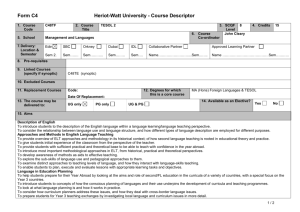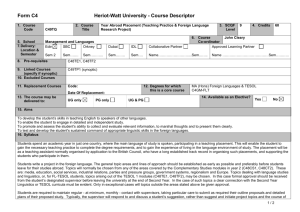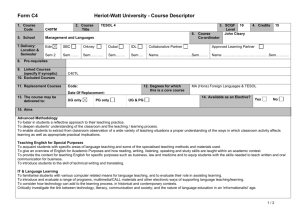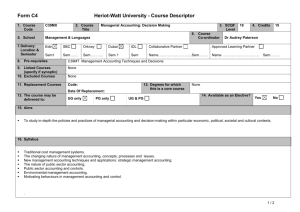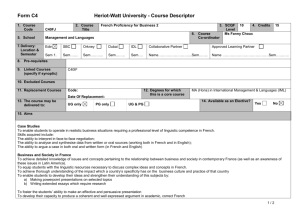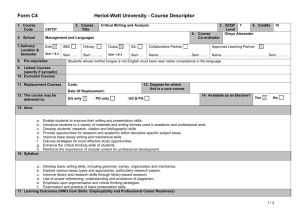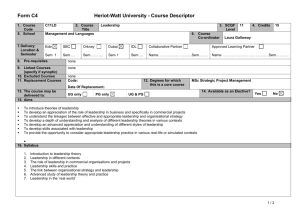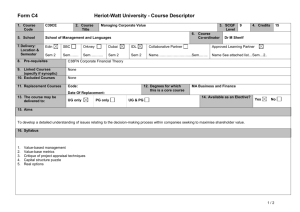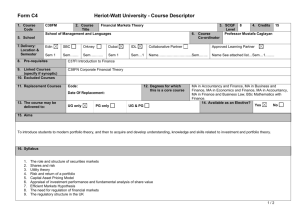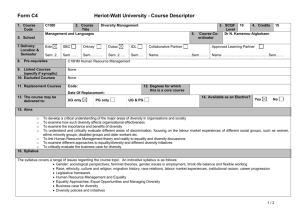C48TE_C4 - Heriot
advertisement
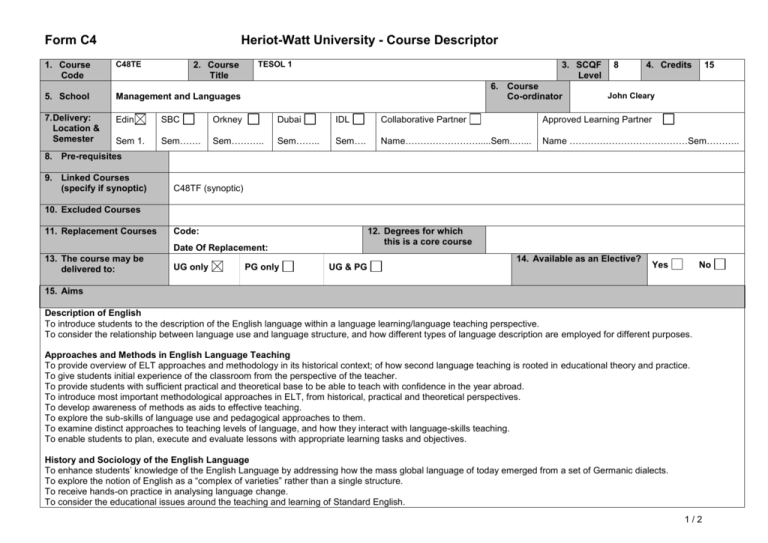
Form C4 Heriot-Watt University - Course Descriptor 1. Course Code C48TE 5. School Management and Languages 7. Delivery: Location & Semester Edin SBC Orkney Dubai IDL Collaborative Partner Approved Learning Partner Sem 1. Sem……. Sem……….. Sem…….. Sem…. Name…………………….....Sem..…... Name …………………………………Sem……….. 2. Course Title TESOL 1 3. SCQF Level 6. Course Co-ordinator 8 4. Credits 15 John Cleary 8. Pre-requisites 9. Linked Courses (specify if synoptic) C48TF (synoptic) 10. Excluded Courses 11. Replacement Courses Code: 12. Degrees for which this is a core course Date Of Replacement: 13. The course may be delivered to: UG only PG only UG & PG 14. Available as an Elective? Yes No 15. Aims Description of English To introduce students to the description of the English language within a language learning/language teaching perspective. To consider the relationship between language use and language structure, and how different types of language description are employed for different purposes. Approaches and Methods in English Language Teaching To provide overview of ELT approaches and methodology in its historical context; of how second language teaching is rooted in educational theory and practice. To give students initial experience of the classroom from the perspective of the teacher. To provide students with sufficient practical and theoretical base to be able to teach with confidence in the year abroad. To introduce most important methodological approaches in ELT, from historical, practical and theoretical perspectives. To develop awareness of methods as aids to effective teaching. To explore the sub-skills of language use and pedagogical approaches to them. To examine distinct approaches to teaching levels of language, and how they interact with language-skills teaching. To enable students to plan, execute and evaluate lessons with appropriate learning tasks and objectives. History and Sociology of the English Language To enhance students’ knowledge of the English Language by addressing how the mass global language of today emerged from a set of Germanic dialects. To explore the notion of English as a “complex of varieties” rather than a single structure. To receive hands-on practice in analysing language change. To consider the educational issues around the teaching and learning of Standard English. 1/2 Form C4 Heriot-Watt University - Course Descriptor 16. Syllabus Description of English English phonology, grammar, lexicon and semantics, discourse, pragmatics and writing systems. Pedagogical description and the relationship between describing language accurately and teaching/learning. The emphasis will be practical, giving students as much practice as possible in explaining how different aspects of the English language work. Approaches and Methods in English Language Teaching Overview of chief contemporary TESOL methods; types of language learner and learning styles; practical observation, lesson planning, peer teaching. Practice in teaching real students. Needs analysis, syllabus design; language skills (listening, speaking, reading and writing) and their sub-skills; teaching linguistic levels (as covered in Descriptions of English); evaluating resources; classroom management; learner differences. History and Sociology of the English Language Issues such as: What do we include in ‘English’? How English was standardised. Language change over time (grammar, vocabulary and pronunciation). The ‘new Englishes’. What standards should we teach? Political correctness in language? English in the 21st century. 17. Learning Outcomes (HWU Core Skills: Employability and Professional Career Readiness) Subject Mastery Understanding, Knowledge and Cognitive Skills Personal Abilities Scholarship, Enquiry and Research (Research-Informed Learning) Demonstrate both a broad and detailed knowledge and understanding of TESOL. Undertake critical analysis, evaluation and synthesis of ideas, concepts, information, and issues relating to of TESOL. Industrial, Commercial & Professional Practice Autonomy, Accountability & Working with Others Communication, Numeracy & ICT Convey complex information to a range of audiences and for a range of purposes. Exercise autonomy and initiative. Take continuing account of own and others’ roles, responsibilities and contributions in carrying out and evaluating TESOL-related tasks. Deal with professional issues in accordance with current practices under guidance. 18. Assessment Methods 19. Re-assessment Methods Method Duration of Exam Weighting (%) Synoptic courses? Method (if applicable) Duration of Exam (if applicable) Continuous Assessment - 40% Written Exam 3 hours 60% C48TF Resubmission of assessed work (in the case of non-submission) Written exam 3 hours 20. Date and Version Date of Proposal Date of Approval by School Committee Date of Implementation Version Number 2/2 Diet(s)
